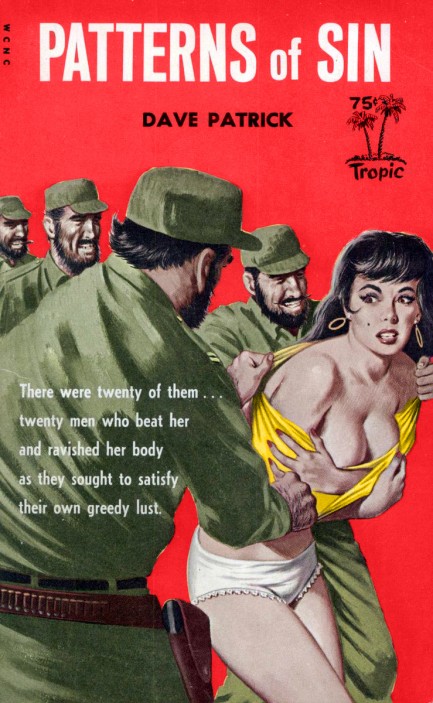| Vintage Pulp | Aug 25 2017 |

Cuban program to clone Fidel Castro goes horribly wrong. Multiple Castros result—but all are rampaging capitalists.

The lead character in Dave Patrick's 1965 novel Patterns of Sin is a college professor and ex-CIA operative named Thomas Keith who happens to be a millionaire. Only in sleaze fiction, right? When his latest girlfriend is almost kidnapped by rogue Cubans, he suspects there's more to her than meets the eye, and there is—she fled to the U.S. after some particularly sticky island dealings involving a long lost twin brother/incestuous lover who was a famed counter-revolutionary. Sadly, there are no clones, but who needs 'em? The incest angle is weird enough: “Tom had so reminded her of her brother that she'd almost called him by her brother's name as they made love.” She actually tells Thomas about her brother, and he's fine with it.
“Are you sure, Tom?” she whispered.
“Do the other women I've had bother you?”
“No, but men are supposed to be different. They're supposed to want virgins.”
“Every girl's a virgin to me, until I've made love to her.”
The government is interested in Tom's girlfriend and her Cuban connection, so he's brought back into the CIA, given a hot partner and—this being a sleaze novel—the partner is a woman with whom he has a steamy history. But they don't get together—the partner is gay now, prefers the Cuban girlfriend, and gets her. Thomas's reaction? “It's a waste of a beautiful woman as far as I'm concerned, but it's your life.” You may be wondering if there's any actual plot here. Not enough to matter. The anti-commie aspect is a mere placeholder between love scenes. The book was bad. We knew it would be bad. But we had to find out what it was about. It wasn't about clones the way the cover art might make you think, but maybe it should have been. That art, by the way, is by Bill Edwards—the mole on his female figures always gives it away.
“Are you sure, Tom?” she whispered.
“Do the other women I've had bother you?”
“No, but men are supposed to be different. They're supposed to want virgins.”
“Every girl's a virgin to me, until I've made love to her.”
The government is interested in Tom's girlfriend and her Cuban connection, so he's brought back into the CIA, given a hot partner and—this being a sleaze novel—the partner is a woman with whom he has a steamy history. But they don't get together—the partner is gay now, prefers the Cuban girlfriend, and gets her. Thomas's reaction? “It's a waste of a beautiful woman as far as I'm concerned, but it's your life.” You may be wondering if there's any actual plot here. Not enough to matter. The anti-commie aspect is a mere placeholder between love scenes. The book was bad. We knew it would be bad. But we had to find out what it was about. It wasn't about clones the way the cover art might make you think, but maybe it should have been. That art, by the way, is by Bill Edwards—the mole on his female figures always gives it away.




































































